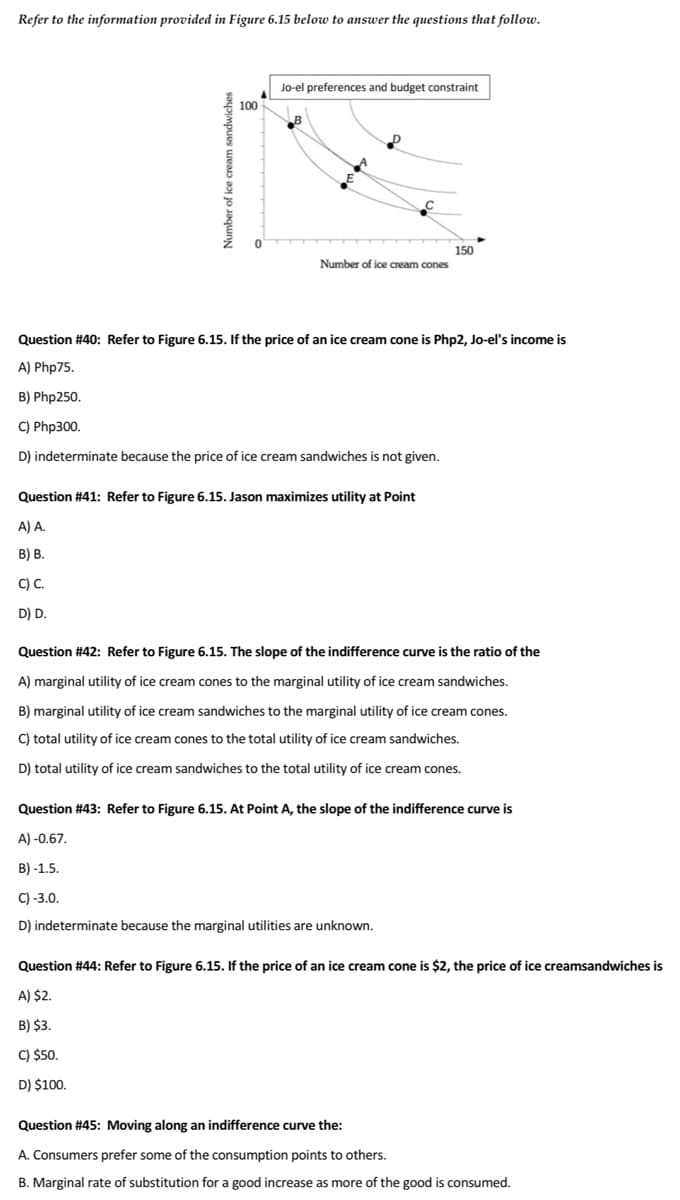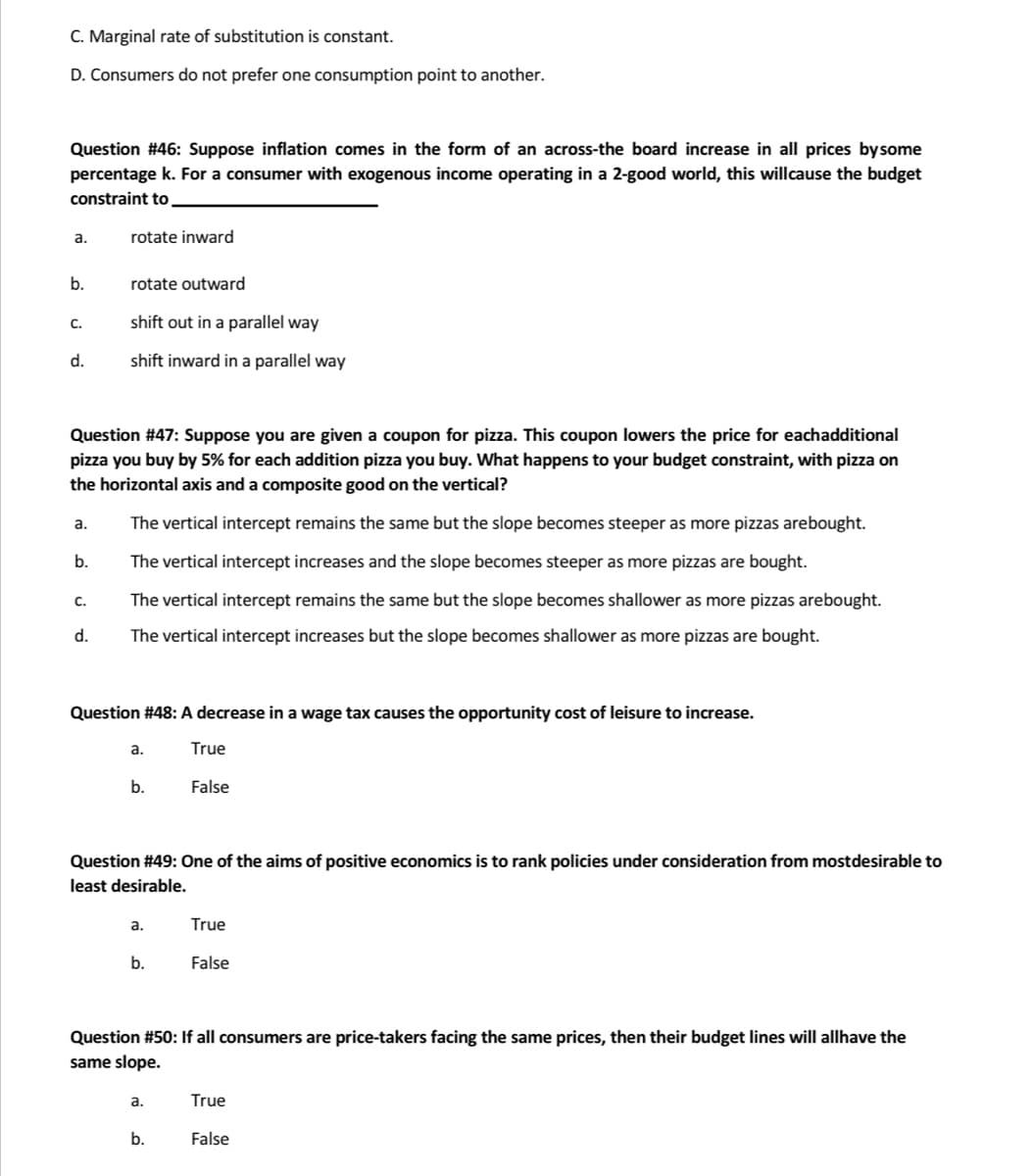Refer to the information provided in Figure 6.15 below to answer the questions that follow. Number of ice cream sandwiches 100 Jo-el preferences and budget constraint E Number of ice cream cones 150 Question # 40: Refer to Figure 6.15. If the price of an ice cream cone is Php2, Jo-el's income is A) Php75. B) Php250. C) Php300. D) indeterminate because the price of ice cream sandwiches is not given. Question # 41: Refer to Figure 6.15. Jason maximizes utility at Point A) A. B) B. C) C. D) D. Question # 42: Refer to Figure 6.15. The slope of the indifference curve is the ratio of the A) marginal utility of ice cream cones to the marginal utility of ice cream sandwiches. B) marginal utility of ice cream sandwiches to the marginal utility of ice cream cones. C) total utility of ice cream cones to the total utility of ice cream sandwiches. D) total utility of ice cream sandwiches to the total utility of ice cream cones.
Refer to the information provided in Figure 6.15 below to answer the questions that follow. Number of ice cream sandwiches 100 Jo-el preferences and budget constraint E Number of ice cream cones 150 Question # 40: Refer to Figure 6.15. If the price of an ice cream cone is Php2, Jo-el's income is A) Php75. B) Php250. C) Php300. D) indeterminate because the price of ice cream sandwiches is not given. Question # 41: Refer to Figure 6.15. Jason maximizes utility at Point A) A. B) B. C) C. D) D. Question # 42: Refer to Figure 6.15. The slope of the indifference curve is the ratio of the A) marginal utility of ice cream cones to the marginal utility of ice cream sandwiches. B) marginal utility of ice cream sandwiches to the marginal utility of ice cream cones. C) total utility of ice cream cones to the total utility of ice cream sandwiches. D) total utility of ice cream sandwiches to the total utility of ice cream cones.
Chapter10: Consumer Choice Theory
Section: Chapter Questions
Problem 8P
Related questions
Question

Transcribed Image Text:Refer to the information provided in Figure 6.15 below to answer the questions that follow.
sandwiches
100
Jo-el preferences and budget constraint
Number of ice cream cones
с
Question #41: Refer to Figure 6.15. Jason maximizes utility at Point
A) A.
B) B.
C) C.
D) D.
Question # 40: Refer to Figure 6.15. If the price of an ice cream cone is Php2, Jo-el's income is
A) Php75.
B) Php250.
C) Php300.
D) indeterminate because the price of ice cream sandwiches is not given.
150
Question # 42: Refer to Figure 6.15. The slope of the indifference curve is the ratio of the
A) marginal utility of ice cream cones to the marginal utility of ice cream sandwiches.
B) marginal utility of ice cream sandwiches to the marginal utility of ice cream cones.
C) total utility of ice cream cones to the total utility of ice cream sandwiches.
D) total utility of ice cream sandwiches to the total utility of ice cream cones.
B)-1.5.
C) -3.0.
D) indeterminate because the marginal utilities are unknown.
Question #43: Refer to Figure 6.15. At Point A, the slope of the indifference curve is
A) -0.67.
Question # 44: Refer to Figure 6.15. If the price of an ice cream cone is $2, the price of ice creamsandwiches is
A) $2.
B) $3.
C) $50.
D) $100.
Question #45: Moving along an indifference curve the:
A. Consumers prefer some of the consumption points to others.
B. Marginal rate of substitution for a good increase as more of the good is consumed.

Transcribed Image Text:C. Marginal rate of substitution is constant.
D. Consumers do not prefer one consumption point to another.
Question # 46: Suppose inflation comes in the form of an across-the board increase in all prices by some
percentage k. For a consumer with exogenous income operating in a 2-good world, this will cause the budget
constraint to
rotate inward
a.
b.
C.
d.
Question #47: Suppose you are given a coupon for pizza. This coupon lowers the price for eachadditional
pizza you buy by 5% for each addition pizza you buy. What happens to your budget constraint, with pizza on
the horizontal axis and a composite good on the vertical?
The vertical intercept remains the same but the slope becomes steeper as more pizzas arebought.
The vertical intercept increases and the slope becomes steeper as more pizzas are bought.
The vertical intercept remains the same but the slope becomes shallower as more pizzas arebought.
The vertical intercept increases but the slope becomes shallower as more pizzas are bought.
a.
b.
C.
rotate outward
shift out in a parallel way
shift inward in a parallel way
d.
Question # 48: A decrease in a wage tax causes the opportunity cost of leisure to increase.
True
False
a.
b.
Question #49: One of the aims of positive economics is to rank policies under consideration from mostdesirable to
least desirable.
a.
b.
a.
True
Question # 50: If all consumers are price-takers facing the same prices, then their budget lines will allhave the
same slope.
b.
False
True
False
Expert Solution
This question has been solved!
Explore an expertly crafted, step-by-step solution for a thorough understanding of key concepts.
This is a popular solution!
Trending now
This is a popular solution!
Step by step
Solved in 3 steps

Knowledge Booster
Learn more about
Need a deep-dive on the concept behind this application? Look no further. Learn more about this topic, economics and related others by exploring similar questions and additional content below.Recommended textbooks for you

Exploring Economics
Economics
ISBN:
9781544336329
Author:
Robert L. Sexton
Publisher:
SAGE Publications, Inc



Exploring Economics
Economics
ISBN:
9781544336329
Author:
Robert L. Sexton
Publisher:
SAGE Publications, Inc



Principles of Economics 2e
Economics
ISBN:
9781947172364
Author:
Steven A. Greenlaw; David Shapiro
Publisher:
OpenStax